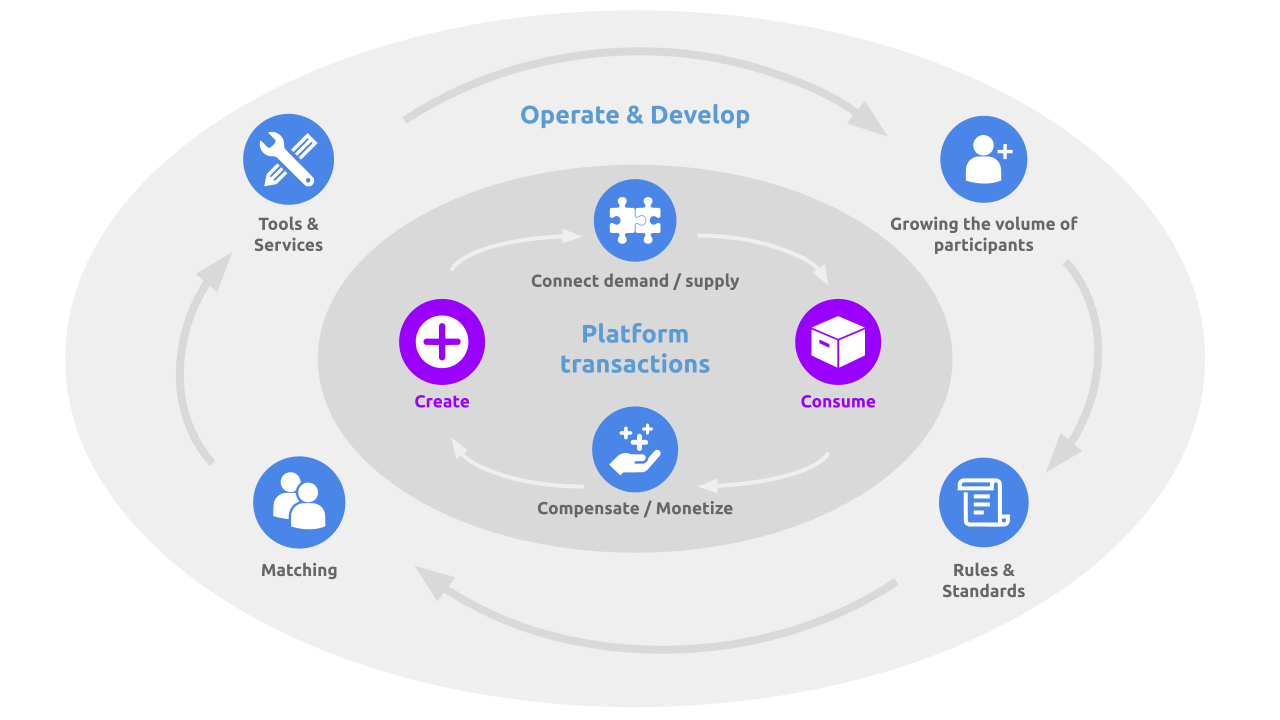Basics of digital platform business
One of the key elements of growth for organizations is the processes by which operations are standardized. Through these, activities can be measured and, by further shaping processes, activities can be made more efficient.
The efficiency and growth of the digital platform and sub-ecosystems is based not only on the digitization of processes, but also on the standardization of many issues such as data structure, technical interfaces (APIs), but above all on standardization of terms of use, standardization (such as Uber).
Instead of negotiating contracts with each customer or supplier individually, certain standard practices are created on the platform, allowing anyone who accepts the terms to join, use materials, provide services, etc., thus creating both significant efficiencies and a better and more predictable customer experience.
Especially in the early stages, from the perspective of validating the platform’s operations, it is essential to focus on assessing customer needs to validate genuine demand and customer experience. Supply is generally easier to enable. The top supply can even be bought or produced by yourself, and only later replaced according to the logic of the platform business. Once a sufficient scale has been reached, the focus of platform growth will focus on a balanced increase in supply and demand relative to platform expansion.
Below is a general description of how the digital platform works and a list of things that the platform needs to handle well and with a good user experience for all parties to succeed.
The efficiency and growth of the digital platform and sub-ecosystems is based not only on the digitization of processes, but also on the standardization of many issues such as data structure, technical interfaces (APIs), but above all on standardization of terms of use, standardization (such as Uber).
Instead of negotiating contracts with each customer or supplier individually, certain standard practices are created on the platform, allowing anyone who accepts the terms to join, use materials, provide services, etc., thus creating both significant efficiencies and a better and more predictable customer experience.
Especially in the early stages, from the perspective of validating the platform’s operations, it is essential to focus on assessing customer needs to validate genuine demand and customer experience. Supply is generally easier to enable. The top supply can even be bought or produced by yourself, and only later replaced according to the logic of the platform business. Once a sufficient scale has been reached, the focus of platform growth will focus on a balanced increase in supply and demand relative to platform expansion.
Below is a general description of how the digital platform works and a list of things that the platform needs to handle well and with a good user experience for all parties to succeed.
|
Operation and development
The operation and development of the platform includes the following core functions; increasing the number of parties, matching, creating rules and standards, and providing key tools and core services (e.g., user support, payment transactions, etc.). These are the core issues that allow the parties to make transactions.
|
Platform Transactions
The core transactions that the parties seek to make happen are; create supply, combine supply and demand, use supply and compensation. The platform does not control all phases, but builds an infrastructure that supports and encourages these.
|
Versions
If we look at the evolution of platform business models over time, they can be roughly divided into three different version types.
As such, all of these version models are still applicable to numerous of the latest platform businesses, and starting with one version does not mean that the strategic goal with growth could not be to switch from one version to another in any direction.
- Versions 1.0, are more free and open to all platforms, and where the touch and control of the platform owner / operator has been relatively light. More reminiscent of the “marketplace online” type of approach, such as ebay, yellow stock exchange, huuto.net, etuovi.com, etc.
- Versions 2.0, where the platform owner takes a clearly stronger curatorial role in managing the customer experience relative to their own brand, such as Airbnb, Wolt, etc.
- Versions 3.0, in which the platform's own deepen its own regulation even further under its own brand, both in the management of the customer experience and especially in pricing. An example of this type of platform is uber, fiver.
As such, all of these version models are still applicable to numerous of the latest platform businesses, and starting with one version does not mean that the strategic goal with growth could not be to switch from one version to another in any direction.

